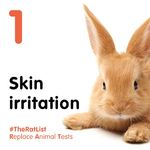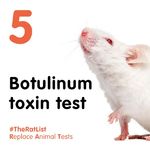Making Alternatives a Priority (MAP) - Laura Alvarez, Senior Science Advisor Cruelty Free International
←
→
Page content transcription
If your browser does not render page correctly, please read the page content below
Making Alternatives a
Priority (MAP)
Laura Alvarez, Senior Science Advisor
Cruelty Free International
Laura.Alvarez@crueltyfreeinternational.orgAbout Cruelty Free International
Award-winning campaigning,
political lobbying, pioneering
undercover investigations,
The leading organization scientific & legal expertise
working solely to end animal
testing worldwide Working with governments,
regulators, companies and
partner organisations
worldwideICCVAM Strategic Roadmap
Multi-agency strategy for toxicity testing to improve human relevance and reduce the use of animals
Goal 3: Encourage the adoption and use of new methods
and approaches by federal agencies and regulated
industries.
• Provide clear language regarding the acceptance of
NAMs
• Collaborate with international partners to facilitate
global harmonization and regulatory acceptance
• Explore processes to incentivize and promote the use of
NAMs
• Identify appropriate metrics for prioritizing activities,
monitoring progress, and measuring success.Making Alternatives a Priority Here are 10 animal tests that could stop now in the US due to the availability of internationally accepted non-animal methods.
Test Progress in EU No. of EU Progress in US
tests
1 Skin irritation Since 2016 EU REACH legislation no longer requires the 4,120 FDA no longer recommends stand-alone skin irritation studies.
animal test. Waivers accepted by EPA since 2012.
2 Eye irritation Since 2016 EU REACH legislation no longer requires the 814 CDER recommends alternatives for reformulated topical drug
animal test. products and accepts waivers for other products. Waivers accepted
by EPA since 2012.
3 Skin sensitization Since 2016 EU REACH legislation no longer requires the 47,341 Since 2020 FDA accepts alternatives for screening purposes but
animal test. prefers guinea pig tests over LLNA. Since 2018 EPA accepts
alternatives for single chemicals, not mixtures.
4 Pyrogenicity MAT introduced in Ph. Eur in 2009 and strongly encouraged 35,172 FDA issued guidance in 2012 stating that the MAT or rFC can be
as a replacement in 2016. rFC method introduced in 2016 used after product-specific validation.
and given its own chapter in 2020.
5 Botulinum toxin Cell-based method included in Ph. Eur since 2012 and three 400,000 Between 2011 and 2019 three major manufacturers have had the
batch potency major manufacturers received EU-wide approval between cell-based method approved by the FDA.
test 2011 and 2018.
6 Antibody In 2020, ECVAM recommended that companies switch to 200,000 Events have been held by NICEATM and ICCVAM to discuss the
production the ‘phage display’ alternative method. advantages of moving away from animal-based antibodies.
7 Leptospira vaccine Ph. Eur updated in 2015 to include option to waive hamster 3,826 In 2013 USDA published guidance for obtaining exemption to
batch potency test based on ‘consistency of production’. hamster test. 60% of companies thought to have transitioned to
the ELISA.
8 Target and LABST deleted from the Ph. Eur in 1997 and TABST deleted 5,000 TABST and LABST waivers have been accepted in US as per VICH
laboratory safety in 2012, except for 3 vet vaccines. guidelines since 2013 and 2019, respectively.
of vet vaccines
9 Abnormal toxicity Test completely deleted from the Ph. Eur in 2017. 25,000 No longer required since 2015 but companies have to proactively
batch test request for test to be removed from their product licences.
10 Shellfish toxin In 2019, mouse test was removed from EU regulation as the 41,515 In 2014, Maine became the first state in the US to receive FDA
batch safety reference method for detecting PSP toxins. approval to use the HPLC method.Barriers to Replacement Lack of global harmonization (e.g. skin sensitization) Lack of regulatory enforcement (e.g. botox batch potency) Need for a defined approach (e.g. eye irritation) Product specific validation required (e.g. pyrogenicity, botox) Availability of the alternative (e.g. antibody production)
The ADAPT principles for regulatory authorities
Assessment - WHO assesses if the method
appropriate for that sector?
Decision - WHEN is a decision made on
acceptability?
Acceptance - WHERE is the decision
published?
Policing - WHY might animal tests still be done?
Transparency - WHAT is done to educate
potential users?Suggested actions for regulators
Lack of regulatory enforcement is one of the main barriers to complete replacement for all
10 of these animal tests.
We strongly encourage regulators to apply the ADAPT principles and to actively pursue the
action items set out in ‘goal 3’ of ICCVAM’s strategic roadmap:
• Investigate which of these animal tests are still being conducted, at what scale, and why
(e.g. through workshops, dedicated working groups, surveys etc.)
• Issue clear guidance on the acceptance and use of alternatives
• Prioritize and incentivize use of alternatives
• Reject submissions for new products where animal tests are still used
Laura.alvarez@crueltyfreeinternational.org
CrueltyFreeInternational.orgYou can also read



























































